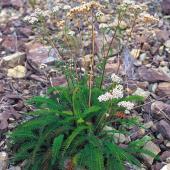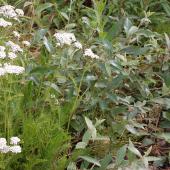Yarrow
Gwichya Gwich'in Name:
at'àn dagą̀įį
Teetł’it Gwich’in Name::
at'àn dagàii
Latin Name:
Achillea millefolium
Categories:
Uses:
As medicine
The boiled liquid from this plant has many medicinal uses. The whole plant including the white flowers can be boiled to make a tea that provides relief from coughs or ulcers.
Source: Andre, Alestine and Alan Fehr, Gwich'in Ethnobotany, 2nd ed. (2002)
The common yarrow and the Siberian yarrow plants both have the same medicinal uses. The above ground parts of the plant are used to make a poultice or tea and the flowers are used to make a poultice. The medicines are used to treat colds, headaches, to stop bleeding or to relieve a sore throat, itchiness from black fly bites and skin ailments. Ruth Welsh said,
For relieving headaches, you steam yourself with it.
To stop bleeding, a poultice is made and put on a cut that is bleeding profusely. Ruth Welsh added,
You...crush the plant up and apply it to the bleeding area. That will coagulate the blood...and stop it from bleeding. You'll slow it down.
A tea is made from the whole yarrow plant and used as a gargle to relieve a sore throat. Ruth said,
You can drink some of the tea but you drink it very diluted, not strong.
The leaves and the flowers are crushed up and applied as a poultice to relieve black fly, bee stings or insect bites. A poultice applied to infected black fly bites around the hairline or around the ankles of children will reduce any swelling or stop the itching. A wash is made out of the plant and used for skin ailments like sun rashes or eczema.
Source: Andre, Alestine, Nan t'aih nakwits'inahtsìh (The Land Gives Us Strength) (2006)






